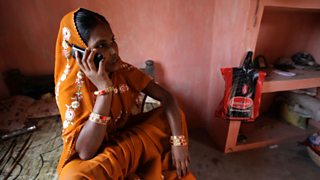The circle of life: A 360-degree approach to communication
Siddhartha Swarup
Βι¶ΉΤΌΕΔ Media Action’s Deputy Country Director, India

56% of households in rural Bihar have mobile phones.
Influencing one person to change just one thing about their behaviour is an extremely difficult task. For example, if I want my son to wash his hands before dinner every evening, I know I have my work cut out. Now imagine doing this for 26 million people?
That's the challenge facing Βι¶ΉΤΌΕΔ Media Action in India with their project .Μύ The state in northern India has the lowest uptake of health services and some of the highest neonatal and maternal mortality rates in the country. But how do you unpack the complex reasons behind the leading to such poor statistics? Our answer is a approach. And to show how it works, let me tell you a story.
Meet Jalebi Devi. A chatty but shy 19-year-old, she's a housewife in a village in the Khagaria district of Bihar. She had to marry before she turned 18 and has just had her first child. She lives with her husband's parents and his unmarried siblings and has no say in household matters. Jalebi is desperate to have sons to improve her status within the family and wants a better life for her newborn: more money, better living conditions and an education. But she's resigned to her fate as the family's workhorse.
But then Jalebi is visited by a community health worker, a local woman who has been trained by Βι¶ΉΤΌΕΔ Media Action's mobile phone based course, .
The health worker tells Jalebi that since she's just had her baby, she could now start thinking about spacing her children's births and planning her family. The health worker also has a multimedia job aid called , which uses a deck of cards with health advice supported by audio messages played over a mobile phone. Jalebi is intrigued by the card about birth spacing and eagerly listens to the message on the health worker's mobile.
But how can she even start to discuss a topic like this with her husband Ramlal? He only seems to listen to his mother and never takes Jalebi's opinions seriously. So Jalebi hatches a plan: when the health worker visits again, she persuades her husband to listen to the Mobile Kunji message – as voiced by Dr Anita, the resident expert on both Mobile Kunji and Mobile Academy.
Ramlal's interest is sparked – especially because he and his friends recently enjoyed a performance about family planning and he likes the idea of being seen as a smart man in control of his family. But while he thinks Dr Anita – or Daktarni Anitaji as she's known locally - talks sense, he's not quite ready yet to broach the topic with his wife. His mother Phoolan wouldn't approve one bit! Phoolan wants at least two or three grandsons and controls the purse strings of the household.
But later that night, Ramlal sees , an advert that pops up on TV. It encourages couples to talk to each other about leaving a three year gap between the first and second child. Ramlal and Jalebi start a hesitant conversation and agree that yes, they should find out more. One problem remains – how to persuade Ramlal's mother?
Phoolan, meanwhile, is visited by a friend who's become a member of a which has sprung up around a radio show called (Mehendi Opens A Window). Her friend can't stop talking about the great time she had chatting about one episode which was all about how the desire for a male child can upset everything - and how this amazing character, Daktarni Anitaji, gives advice on birth spacing (yes, the very same Dr Anita whom Jalebi heard on Mobile Kunji).
At first, Phoolan is a bit cynical but she's soon tuning in to Khirki Mehendiwali three times a week and even the omnibus on the weekend. The combination of drama, information and advice has her hooked. So when her son suggests that she subscribe to the mobile service - where families can receive recorded messages from Dr Anita - she's willing to give it a try. And when the call comes in, she finds herself agreeing with the doctor and orders Ramlal to take Jalebi to the health centre to find out more. Ramlal and Jalebi have already been using Kilkari, so they know what to expect even before going to the health centre.
Ramlal and Jalebi are talking a lot more. Jalebi's voice is heard more within the family. Things are looking up for her and her child.
Now, while everyone's story might not run quite so smoothly, this tale embodies our 360-degree approach to affect people's knowledge, attitudes, social norms and, finally, behaviour. We are using multiple, distinct, yet complementary channels of communication which work together to create a whole that is greater than the sum of its individual parts.
So mass media such as the TV advert Ek Teen Do and radio shows like Khirki Mehendiwali complement community activities such as listening clubs and street theatre. These are reinforced with face-to-face work through health workers on the ground, while mobile phones – now owned by over half of rural households in Bihar – deliver information and advice.
As people hear the same message from multiple sources on how to keep babies and mothers healthy, opinions can be shaped at scale and individual and societal norms more rapidly transformed.
But how to get my son to wash his hands before dinner?
Well, I’m working on it.
Μύ
Related links:
Μύ
From the Βι¶ΉΤΌΕΔ Media Action blog:
Elsewhere on Βι¶ΉΤΌΕΔ Media Action:
Μύ
